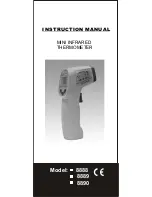
Heat-Prober
®
Platinum-RTD Thermometers User Manual
17
6.5 Span Adjustment Using Wahl Calibrator
1. Set Wahl Calibrator for 284°F/140°C and apply power to the meter. Adjust R35 (R16
on HP.) clockwise for a display of 284.0°F or 140.0°C.
2. Repeat the zero span adjustment until the meter reads 32.0°F/0.0°C exactly, and
reads
212°F/100°C or 284°F/140°C within accept- able limits of error.
Since only one span adjustment covers both low and high scales, any error that must be
tolerated should be pushed to the high scale where percentage wise it will be less of an error.
6.6 Adjustment Using Decade Resistance Box
Basic Theory: Platinum has a well defined resistance versus temperature curve. Accordingly, if
a decade resistor is put in the place of the probe to simulate the standard platinum element, a
quick and accurate calibration can be achieved.
6.6.1. Setup and Calculations
The decade resistor box may be used as the source to perform a standard calibration. A coiled
cord cable with connector for the Wahl probe should be used (Model Number 10434-01). This
has an approximate resistance of 0.36 ohms. The actual resistance should be determined for
your setup and this value used in the calculations. The total resistance to be simulated is
.94ohms above the sensor resistance specified in the ITS90 Platinum Resistance Tables for
100 ohm, .00385 ohm/ohm/degree C sensors. Therefore, the decade resistance setting should
be a table value plus 0.94 ohms minus the actual cable resistance measured above i.e. the
decade box setting for 0°C should be: 100.00 + 0.94 - 0.36 = 100.58 ohms.
Note
: for HP models do not subtract cord resistance in calculation steps. Use coiled cord Model
Number 10434-02.
Step 1: Set the Decade Box for a total resistance (decade box + lead resistance) for
100.94 ohms and adjust zero control R5 for a display reading of 0.0°C or 32.0°F, ±0.1°.
Step 2: Set the Decade Box for a total resistance (decade box + lead resistance) for
154.52 ohms and adjust span control R35 (R16 for HP models) for a display reading of 140.0°C
or 284.0°F, ±0.1°.
Step 3: Repeat Steps 1 and 2 as necessary for optimum calibration.
















































